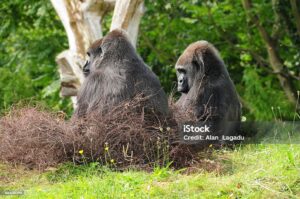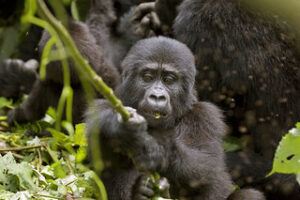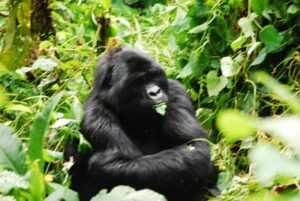Gorilla trekking Vs Gorilla tracking
Both Gorilla trekking and Gorilla tracking involve identifying and meeting gorillas within their habitants, but they are slightly different. whereas Gorilla trekking involves the tourist searching for gorilla with the assistance of the tour guide, tracking is the process of identify where they are by the trackers before the tourist embark on the journey as explained below.
What is gorilla tracking?
Gorilla trekking involves moving up and down in search for Gorilla. From where they were left a day prior until where they’ll be found the next morning. While tracking gorillas, we have got a team of adverse trackers who are dedicated rangers, they always move early in the morning in search for different Gorilla families.
How to track gorillas
While tracking the gorillas, the rangers will always move up to a point where a family was left a day before. Once they reach there, they start following the evening trails. That process works up to a point where they nested for a night. Once they get the nest in their sight, they start following the early morning trails, which will lead them to where the gorillas are feeding from in the morning.
However, this is not just a matter of following trails. These people must be observant on several signs like.
Vegetation bending
One of the signs that truckers look at while tracking the gorillas, Includes the vegetation bandings. Gorillas are formed of trampoline and pulling the vegetation towards the direction, they are heading to. So, if we find out that the vegetation is bending downhill, it is a clear indication that the gorilla went downhill. So, the trackers will have to continue with the downhill trails.
Looking for gorilla fingerprints
We also look at signs like the gorilla fingerprints. While moving mostly during the rainy days and on bare ground, we can easily observe the gorilla fingerprints and where the Gorilla fingerprints are facing. It is an indication that the animals took that direction.
dang droppings
The other sign that we also look at includes the dang droppings. Gorillas are fond of defecating along their Trails as they move. And coming across the dang droppings. It is one of the ways to clearly ascertain that we are following the gorilla Trails Then you also look at signs like the food leftovers.
Vegetation Leftovers
Gorillas are vegetarians, but they are quite selective as they feed. Whereby, some of the plants they feed on the leaves. The back, the inner parts and the fruits. So, while feeding they are fond of leaving part of the food that they feed on and whenever we come across a point where the animals fed from.
We are in position to tell whether the leftovers are for today, morning, yesterday evening all summer days, back and that will enable us to estimate the distance that the animals could have moved. While following all those signs, the trails will lead the trackers to a point where the animals nested for the night. What you need to note is that gorillas do not repeat to sleep on their previous nightness every night that passes by.
Nest counting
They must make new nightmares. Get the night in their side, trackers do not bypass that area. They must do what we call Nest counting. Counting of the nests is one of the ways of ascertaining that you’re following a right gorilla family in a manner that the number of the nests shall always tally or March with the number of individuals, who are edged four years and above, because those are the members who are in position to make nurse for themselves.
As for the babies, they keep sharing their nightness with their mothers. So, if they count and the numbers are tallying, then the truckers will now continue with the trails while following the similar signs and the trails will lead them to a point where the animals are feeding from the morning.
Reason for not repeating nests

Telephoto image of sitting female primates with nesting material to show her intentions toward the Silverback Gorilla,
Defecate in their nest
To the nests. As I said it earlier that gorillas do not repeat sleep on their previous nightness. You must be imagining that what are the reasons as to why they must keep making new nightness. On of the reasons is that these animals are too lazy in the morning when they are waking up.
They cannot think of moving aside to defecate so they end up defeating on their nightness. Meaning that the smell of the dung, the smell of the poor will push them away, so they must abandon their previous nightness because of the smell of the wastes.
Moving a little bit far from their previous nest
Another reason is that when gorillas wake up from their night Nest side, they start moving in search for food and they end up moving a little bit far away from where they nested for previous night, and they find it hard for them to trace their way back to a point where they nested for previous night. So, they end up nesting where the evening finds them.
Nest making process
In a gorilla family, all members make nightness for themselves with an exception. Of the infants or babies. Babies keep sharing their nightness with their mothers and while nesting, breastfeeding mothers always nest close to the dominant Silverback because they feel their babies are much more asexual well protected when they are close to their father.
Gorillas make their nightness mostly on ground, but sometimes up in trees. While nesting, they make their nightness out of the vegetations they keep folding branches until once they make a huge piling such that one can have a comfortable night. Whenever we visit the nightness site, we are in position to tell Whether this nest is for the Silverback, or this nest is for the baby and the mother, or it is for the blackback.
How differentiate nests for different gorillas
Look at the dung sizes.
Gorilla dang sizes can be used to tell whether the nurse is for the Silverback or juvenile, an infant with a mother in a manner that the dang of the Silverback is always the biggest in the entire family, as it is estimated to be 7.2 centimeters wide. Then we have black box adult, females, and some adult individuals.
Dosa, medium sizes. They are estimated to range from 5.5 centimeters to 7.1 centimeters. Then we have the juveniles, their dang ranges from 4 centimeters to 5.4 centimeters. Then we have the infants from one centimeter to 3.9 centimeter so we can do that estimation very quickly and we can be in position to tell that this nest is for the Silverback or for the baby and the mother and this one is for the black back.
Nest size
We can also observe the nest size. By observing the size of the nest, you can tell its owner silverback make the biggest nest compared to the rest of the family members.
Then the other thing is that the nest of the silverback can easily be identified because Silverbacks are fond of scratching their backs when they are waking up, so they end up leaving their grace far on their nightmares. We can be in position to tell After observing the grass or the silver hair on their nightness, then we can tell that this nurse is for the silver bag.
Gorilla Trekking
While doing the gorilla Tracking experience, gorilla trekking experience is when tourists come and get involved in the exercise of searching for gorillas so that they can meet their expectations.
Gorilla trekking experience is done on daily basis, and we have got for instance, in Bahama sector. We have got seven gorilla families that are visited on daily basis. Here, we register the tourist after registration. Someone will take them through a general briefing.
After the general briefing, tourists will be allocated to different gorilla families that they will be trekking. After they are located different gorilla families, they will then meet their respective Ranger guides who will take them through the entire experience.
Each gorilla family is always allocated. A maximum of eight, tourists, the reason asked why we allocate maximum of eight tourists. We look at groups which can easily be managed by one lead guide while moving in the forest. If you have a bigger group becomes a little bit hard for you to manage that bigger group, so eight people as maximum number, it’s quite manageable. So, a gorilla group can be comprised of a team of Army staffs, rangers with guns.
The reason as to why we come with Rangers with guns, is that we have got other wild animals in the forest. For instance, we have a forest elephants which we do meet sometimes while doing this experience and most of the cases whenever we have got an encounter with the forest elephants, they tend to be aggressive.
Army staff for gorilla trekking
So, the Army staff will have to play Role to make sure that the tourists can be in positioned to continue with the experience and they are safe. So, the Army staff must scare shoot up in air such that we can be positioned to continue with the experience.
support staff(sporters) for gorilla trekking
These come from the neighboring communities, and we encourage tourists to hire Porters at a minimum fee of 20 US dollars, that is purposely aimed at making the tracking day easy and, it’s one of the ways of supporting the local community. So once the team is ready, the lead guide, will now start the experience.
How does gorilla trekking begin
Start by walking
Right from the office. Some groups may require driving to the starting point and all our groups sometimes. They can brave about 1 hour, 45 minutes to get to the starting point. So once you are the starting point, you start moving and the lead guide will keep in touch with the team of the advanced trackers, the Rangers who ahead in search for the gorillas.
The role of a tracker
So, the trackers will keep directing the lead guide on possible shortcuts to make sure they are connected with them quite easily. It would become very hard, if you are to move on your own way, without the directives of the trackers. Therefore, implying that you may end up moving far away. And the tourists may end up getting tired.
This might make some tourist very tired hence failing to make it to where the gorillas are being allocated from. So, to avoid disappointments, the advanced team always must be in front. They keep directing the team with the lead guide as the lead guide keeps on moving.
The role of a guide
Then while walking the lead guide will always create time and offer a lot of information about the forest, the country and gorillas. We also create room for the question session whereby tourists are allowed to ask questions. The lead guide will be in positioned to respond to those questions. Also, while doing the trekking experience, the lead guide also will get time and brief the tourists once you approach the viewing point.
Once you get to the Viewing point, the lead guide will introduce the team of the advanced trackers. The guys who have allocated the gorillas. Then after that, the lead guide will also brief the tourists on how you are to conduct yourselves while viewing the gorillas. Basically, he or she will be looking at the gorilla visitation rules among the gorillas.
gorilla visitation rules
Visitation rules include
- Maintaining a 10-meter distance between tourists and the gorillas.
- tourists to wear their face masks, no one will be allowed to have a view of the mountain gorillas without to a face mask.
- turn to the opposite direction in case they must sneeze or cough. Whenever one feels like he needs to sneeze or cough, you are advised to turn the opposite direction.
- Then we also encourage tourists to remain calm, in case of any charging. We advise, you never to think of running. We request that to stand still look submissive in front of the animal and avoid the direct eye contact. Leave the lead guide to make the peaceful grants to come the animal down. Always listen to the directives of your Preparations.
Viewing gorillas during gorilla trekking
The lead guide will now authorize or allow the tourists to start viewing gorillas. While viewing, you are also advised not take flash photography. We do not allow you to take photos, while your flash is on, you must turn off the flash and continue with the photographing.
Then after a successful trekking experience, your lead guide will bring you back up to the vista’s information centre or from any other point.
When you finish the experience, your lead guide will have to award you the trekking certificates. The certificate is purposely aimed at acting as a confirmation that you visited gorillas. Had a remarkable encounter with the mountain gorillas. Then we shall later, ask you to use the certificate as a marketing tool. To encourage more of your colleagues to come and support the gorilla conservation here in East Africa.
What to come with for gorilla trekking
While tracking here with us, there are a number of items that we ask you to come along with as part of the preparation among them includes.
The good hiking shoes. Bwindi is a tropical rainforest, so the trail sometimes tends to be so slippery mostly during the rainy season. That’s why we urge you to have got good hiking shoes which can grip on ground. This will sure that we avoid cases of one falling and maybe twisting the ankle.
Carry a Sweater for gorilla trekking
We also argue to come with a sweater as whether might change any time. So, it’s important for one to have got a sweater here just such that you avoid being stressed by rain.
Have face mask for gorilla trekking
We also urge you to have got a face mask.
Carry water for gorilla trekking
Then we highly recommend you to have got a minimum of 1.5 liters of drinking water per person. As you keep moving up and down, you need to keep drinking.
Pack lunch
We also urge you to have got packed lunch with you. Gorilla trekking experience is one of the most unpredictable activities.
how long does it take to meet gorillas
Whereby the work can either be a short walk, a medium walk or a long walk. When I talk of a short walk, a short walk can be in between 10 minutes to 45 minutes. Work from the visitor’s information Centre up to where the gorillas have been allocated.
A medium work ranges from 45 minutes to one and a half hours. Is a medium work a long, walk always ranges from 3 hours to 6 hours, or even beyond that. That is what we refer us to a long walk. So, we add you to have got, always your packed lunch, as part of the preparation.
Conclusion
gorilla trekking in East Africa offers a unique opportunity to get close to one of the world’s most endangered and iconic species in their natural habitat. Through strict regulations, careful management, and community involvement, East Africa has successfully established itself as a leader in sustainable gorilla tourism. Providing both economic benefits and conservation incentives.
The experience of encountering mountain gorillas in the wild is not only a memorable adventure for visitors. It also plays a vital role in the ongoing efforts to protect these majestic creatures for future generations.
By respecting guidelines, supporting conservation efforts, and promoting responsible tourism practices. visitors also contribute to the conservation of gorillas and their habitat while enjoying a once-in-a-lifetime wildlife experience in East Africa.




